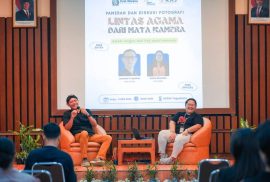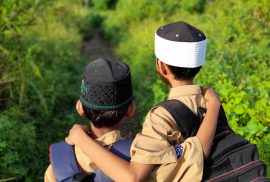David Akbar Hasyemi Rafsanjani
Photography is a powerful art and visual medium for depicting various aspects of life, including religious themes. In the context of religion, photography has an important role in capturing symbols, rituals, and the lives of religious people, and can be a medium to build understanding and tolerance among religious communities, especially in Indonesia. ICRS in collaboration with the Humanities Studies Study Program of Duta Wacana Christian University (UKDW) organized a photography discussion “Lintas Agama dari Mata Kamera”.
This discussion aims to explore how religion is represented through the medium of photography and how photography can be a bridge of understanding related to daily interfaith interactions. In addition, this discussion aims to understand how photography can be an effective medium in depicting the beauty and diversity of spirituality of various religions, as well as its important role in strengthening tolerance and interfaith harmony.
The speakers in this photography discussion event were Vania Sharleen Setyono, M.Si.TEOL, Lecturer of UKDW Humanities Study Program, and Dr. Leonard Chrysostomos Epafras, Lecturer, Researcher, and Trainer at ICRS. Vania explained that photography is a powerful art and visual medium to convey messages on every aspect of life, including interreligious themes. In the context of religion, often interreligious is depicted through the encounter of religious symbols and rituals but in the theme “Everyday Interreligious Engagement”, the process of interfaith encounter is depicted in everyday life and not artificial photos. Through the camera lens, a deep form of tolerance can be captured and become a message that interfaith tolerance has been and can be done in everyday life.
“Photography can be an effective medium in portraying the beauty and diversity of spirituality of various religions, as well as its important role in strengthening tolerance and interfaith harmony. This discussion aims to explore how religion is represented through the medium of photography and how photography can be a bridge of understanding regarding daily interfaith interactions,” she said. Thus, she hopes that students as the younger generation can utilize smartphones and social media to promote interfaith harmony, tolerance, and other good things.
Leonard said that ICRS had previously held a photography competition with the theme “Everyday Interreligious Engagement”. Leonard said that photos and cameras can be instruments that divide and separate. They become the power of Anteros and anti-eros and amplify narcissistic urges. But they also have the opportunity to depict zones of encounter in daily life. “Through this event we want to capture moments of diversity interaction and record religious harmony that occurs in everyday life, then disseminate it to the general public. We want to capture people’s daily lives, natural religious experiences, real-life experiences,” he said.
In a diverse country like Indonesia, where multiple religions coexist, photography offers a way to showcase moments of unity, dialogue, and mutual respect between different religious communities. By capturing these interactions in real-time, photography not only raises awareness but also fosters empathy and encourages a more inclusive narrative of Indonesia’s rich cultural and religious diversity.


























